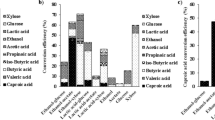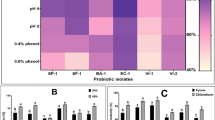Abstract
A gas-lift reactor having a high mass transfer coefficient (k L a = 80.28 h−1) for a relatively insoluble gas (carbon monoxide; CO) was used to enrich (homo)acetogens from animal feces. Samples of fecal matter from cow, rabbit, chicken, and goat were used as sources of inoculum for the enrichment of CO and H2 utilizing microbial consortia. To confirm the successful enrichment, the Hungate roll tube technique was employed to count and then isolate putative CO utilizers. The results of this work showed that CO and H2 utilizing consortia were established for each inoculum source after 8 days. The number of colony-forming units in cow, rabbit, chicken, and goat fecal samples were 3.83 × 109, 1.03 × 109, 8.3 × 108, and 3.25 × 108 cells/ml, respectively. Forty-two colonies from the animal fecal samples were screened for the ability to utilize CO/H2. Ten of these 42 colonies were capable of utilizing CO/H2. Five isolates from cow feces (samples 5, 6, 8, 16, and 22) were highly similar to previously unknown (homo)acetogen, while cow-7 has shown 99 % similarity with Acetobacterium sp. as acetogens. On the other hand, four isolates from chicken feces (samples 3, 8, 10, and 11) have also shown high CO/H2 utilizing activity. Hence, it is expected that this research could be used as the basis for the rapid enrichment of (homo)acetogenic consortia from various environmental sources.



Similar content being viewed by others
References
Abrini J, Naveau H, Nyns EJ (1994) Clostridium autoethanogenum sp. nov., an anaerobic bacterium that produces ethanol from carbon monoxide. Arch Microbiol 161(4):345–351
Allen TD, Caldwell ME, Lawson PA, Huhnke RL, Tanner RS (2010) Alkalibaculum bacchi gen. nov., sp. nov., a novel CO oxidizing, ethanol producing acetogen isolated from livestock-impacted soil. Int J Syst Evol Microbiol 60(10):2483–2489
Belgiorno V, De Feo G, Della Rocca C, Napoli RMA (2001) Energy from gasification of solid wastes. Waste Manag 23(1):1–15
Bharadwaj SS, Schmidt LD (1995) Catalytic partial oxidation of natural gas to syngas. Fuel Process Technol 42(2–3):109–127
Bhatnagar L, Krzycki JA, Zeikus JG (1987) Analysis of hydrogen metabolism in Methanosarcina barkeri: regulation of hydrogenase and role of CO-dehydrogenase in H2 production. FEMS Microbiol Lett 41(3):337–343
Chang IS, Kim DH, Kim BH, Shin PK, Sung HC, Lovitt RW (1998) CO fermentation of Eubacterium limosum KIST612. J Microbiol Biotechnol 8(2):134–140
Chang IS, Kim BH, Kim DH, Lovitt RW, Sung HC (1999) Formulation of defined media for carbon monoxide fermentation by Eubacterium limosum KIST612 and the growth characteristics of the bacterium. J Biosci Bioeng 88(6):682–685
Chang IS (2000) Carbon monoxide fermentation by Eubacterium limosum KIST612. Ph.D. thesis, University of Wales Swansea, Swansea, UK
Chang IS, Kim BH, Lovitt RW, Bang JS (2001) Effect of partial pressure on cell-recycled continuous co fermentation by Eubacterium limosum KIST612. Process Biochem 37(4):411–421
Coulson JM, Richardson JF, Backhurst JR, Harker JH (1999) Chemical engineering. Pergamon Press, Oxford
Demirbas A (2007) Progress and recent trends in biofuels. Energy Combust Sci 33(1):1–18
Dubois JL (2011) Requirements for the development of a bioeconomy for chemicals. Curr Opin Environ Sustain 3(1–2):11–14
Drake HL, Gößner AS, Daniel SL (2008) Old acetogens, new light. Ann NY Acad Sci 1125:100–128
Henstra AM, Sipma J, Rinzema A, Stams AJM (2007) Microbiology of synthesis gas fermentation for biofuel production. Curr Opin Biotechnol 18(3):200–206
Iino T, Mori K, Tanaka K, Suzuki K, Harayama S (2007) Oscillibacter valericigenes gen. nov., sp. nov., a valerate-producing anaerobic bacterium isolated from the alimentary canal of a Japanese corbicula clam. Int J Syst Evol Microbiol 57(8):1840–1845
Keim W (1986) C1 chemistry: potential and developments. Pure Appl Chem 58(6):825–832
Kim BH, Bellows P, Datta R, Zeikus JG (1984) Control of carbon and electron Flow in Clostridium acetobutylicum fermentations: utilization of carbon monoxide to inhibit hydrogen production and to enhance butanol yields. Appl Environ Microbiol 48(4):764–770
Klasson KT, Ackerson MD, Clausen EC, Gaddy JL (1993) Biological conversion of coal and coal-derived synthesis gas. Fuel 72(12):1673–1678
Levy PF, Barnard GW, Garcia-Martinez DV, Sanderson JE, Wise DL (1981) Organic acid production from CO2/H2 and CO/H2 by mixed-culture anaerobes. Biotechnol Bioeng 23:2293–2306
Liou JS-C, Balkwill DL, Drake GR, Tanner RS (2005) Clostridium carboxidivorans sp. nov., a solvent-producing clostridium isolated from an agricultural settling lagoon, and reclassification of the acetogen Clostridium scatologenes strain SL1 as Clostridium drakei sp. nov. Int J Syst Evol Microbiol 55(5):2085–2091
Miller TL, Wolin MJ (1974) A serum bottle modification of the Hungate technique for cultivating obligate anaerobes. Appl Microbiol 27(5):985–987
Moench TT, Zeikus JG (1983) An improved preparation method for a titanium (III) media reductant. J Microbiol Methods 1(4):199–202
Naik SN, Goud VV, Rout PK, Dalai AK (2010) Production of first and second generation biofuels: a comprehensive review. Renew Sustain Energy Rev 14(2):578–597
Novaes E, Kirst M, Chiang V, Winter-Sederoff H, Sederoff R (2010) Lignin and biomass: a negative correlation for wood formation and lignin content in trees. Plant Physiol 154(2):555–561
Riggs SS, Heindel TJ (2006) Measuring carbon monoxide gas-liquid mass transfer in a stirred tank reactor for syngas fermentation. Biotechnol Prog 22(3):903–906
Shen GJ, Shieh JS, Grethlein AJ, Jain MK, Zeikus JG (1999) Biochemical basis for carbon monoxide tolerance and butanol production by Butyribacterium methylotrophicum. Appl Microbiol Biotechnol 51(6):827–832
Tanner RS, Miller LM, Yang D (1993) Clostridium ljungdahlii sp. nov., an acetogenic species in clostridial ribosomal-RNA homology group-I. Int J Syst Bacteriol 43(2):232–236
Van Rossum G, Kersten SRA, Van Swaaij WPM (2007) Catalytic and noncatalytic gasification of pyrolysis oil. Ind Eng Chem Res 46(12):3959–3967
Vega JL, Klasson KT, Kimmel DE, Clause EC, Gaddy JL (1991) Sulfur gas tolerance and toxicity of CO-utilizing and methanogenic bacteria. Appl Biochem Biotechnol 24–25:329–340
Zeikus JG, Lynd LH, Thompson TE, Krzycki JA, Weimer PJ, Hegge PW (1980) Isolation and characterization of a new, methylotrophic, acidogenic anaerobe, the Marburg strain. Curr Microbiol 3(6):381–386
Acknowledgments
This work was supported by the Development of Biohydrogen Production Technology using the Hyperthermophilic Archaea program of the Ministry of Land, Transport, and Maritime Affairs, Republic of Korea. This work was also supported by the Research Program for Agricultural Science and Technology Development (project no. PJ008517032012) and by the Advanced Biomass R&D Center (ABC-2011-0031355) funded by the Ministry of Education, Science and Technology, and the Korea Environment Corporation.
Author information
Authors and Affiliations
Corresponding author
Rights and permissions
About this article
Cite this article
Park, S., Yasin, M., Kim, D. et al. Rapid enrichment of (homo)acetogenic consortia from animal feces using a high mass-transfer gas-lift reactor fed with syngas. J Ind Microbiol Biotechnol 40, 995–1003 (2013). https://doi.org/10.1007/s10295-013-1292-4
Received:
Accepted:
Published:
Issue Date:
DOI: https://doi.org/10.1007/s10295-013-1292-4




